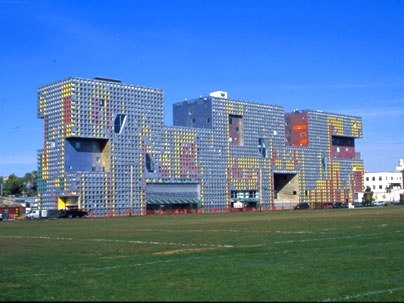Award-winning architect Stephen Holl shared some of the themes running through his building designs, including "porosity," a concept given concrete illustration in Simmons Hall, in his April 4 campus lecture.
His design for the residence hall, sometimes familiarly called the "Space Waffle," sought to open up that area of campus to the neighboring community of Cambridgeport on one side and the Charles River on the other. The exterior walls of the building are dotted with hundreds of tiny, square windows aligned in rows and columns. Holl seemed gratified that the residents had adopted and adapted the space to their needs by selectively lighting up windows to make a smiley face, or swathing the white-plaster walls with graffiti.
Holl organized his presentation in Room 10-250 around five themes -- fragments, porosity, insertions, precincts and fusion -- that have informed his work over the past two decades. His projects display diversity -- museums, churches, housing complexes and commercial buildings -- and manifest his commitment to a sustainable, environmentally sensitive architecture.
His most ambitious porous project is a massive housing development under construction in Beijing, which seeks to break up the grim monotony of the high-rise apartment complexes. The eight towers of Holl's project vary in height and are connected by sweeping walkways. Their lower levels provide space for the necessities of urban China: laundromats, noodle shops, a cinema. It is the largest geothermal residential project in history.
Under the theme he calls "fragments," Holl showed a number of projects that attempt to rein in the ragged sprawl of contemporary urban development. He designed low-cost, densely packed housing complexes in Phoenix, Ariz., and Naning, China, that bracket and protect the natural space and use gray-water recycling and garden roofs to conserve resources.
He gave examples of his urban "insertions" -- bright buildings tucked into existing urban masses -- and "precincts," such as his spectacular wine-center in the Austrian village of Langenlois, which embraces its vineyard setting.
Finally, Holl discussed "fusion," a notion best exemplified by the water-treatment plant he designed for New Haven, Conn., that has turned out to be a prized setting for weddings.
A version of this article appeared in MIT Tech Talk on April 12, 2006 (download PDF).






